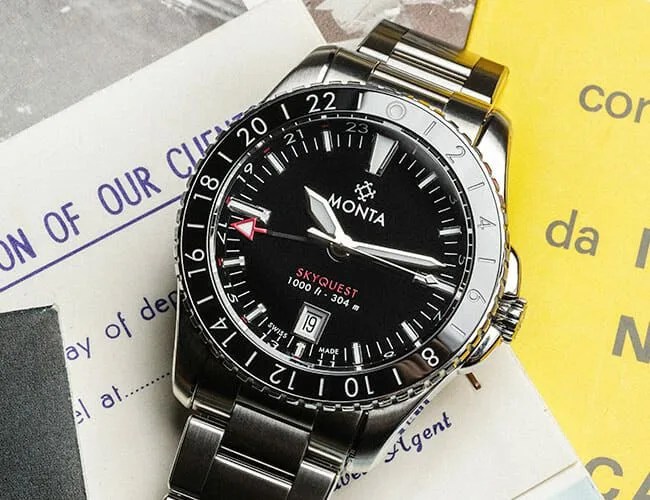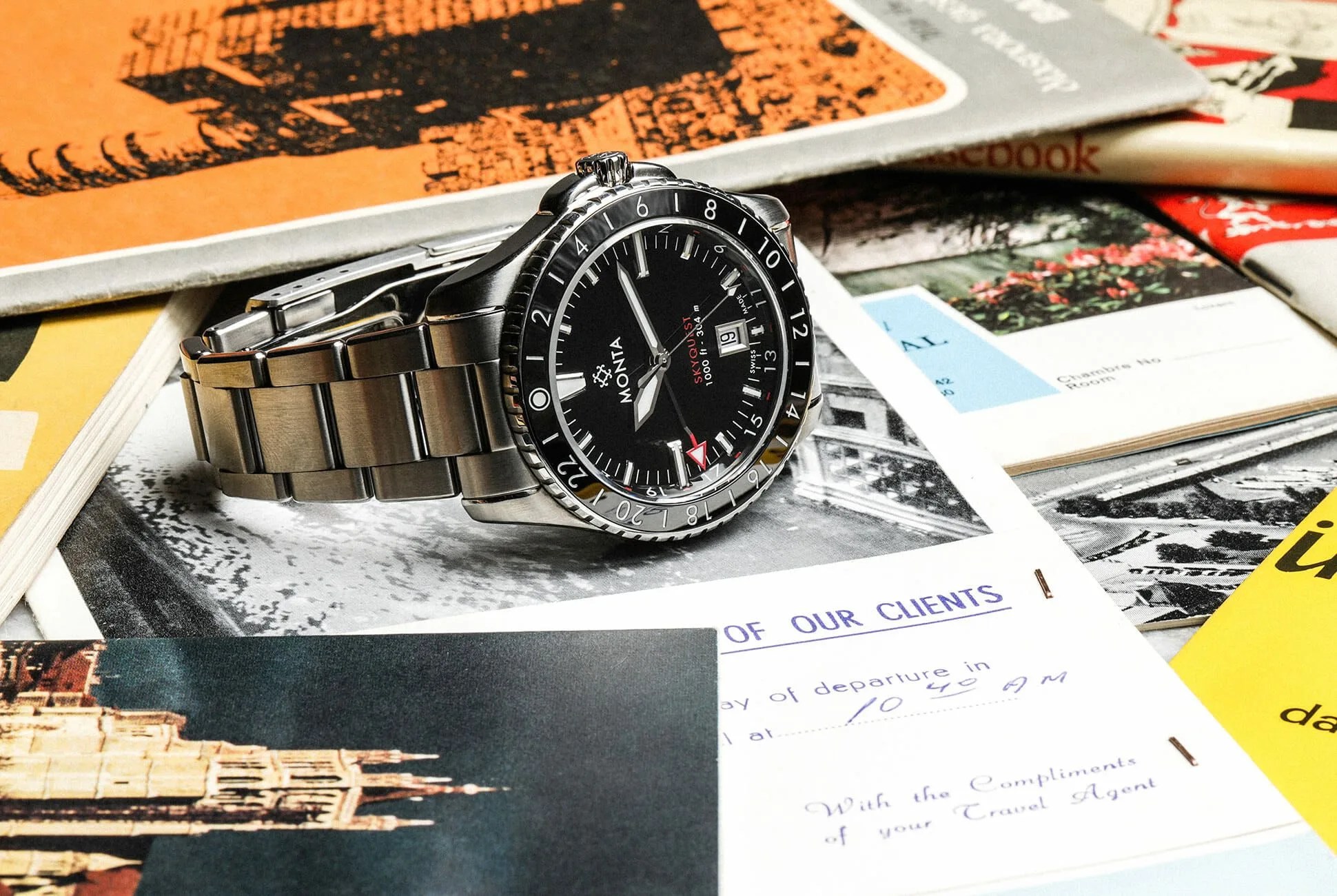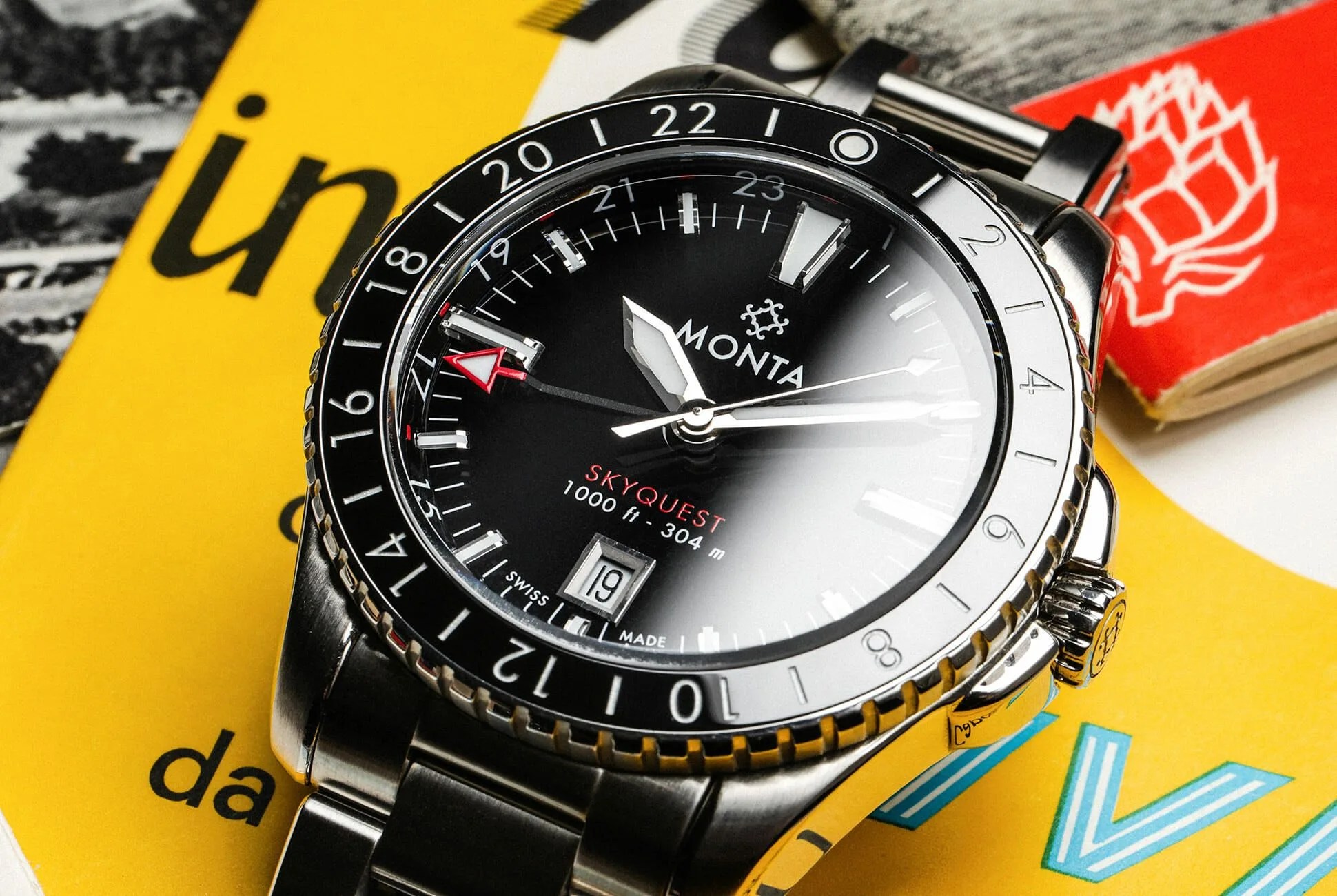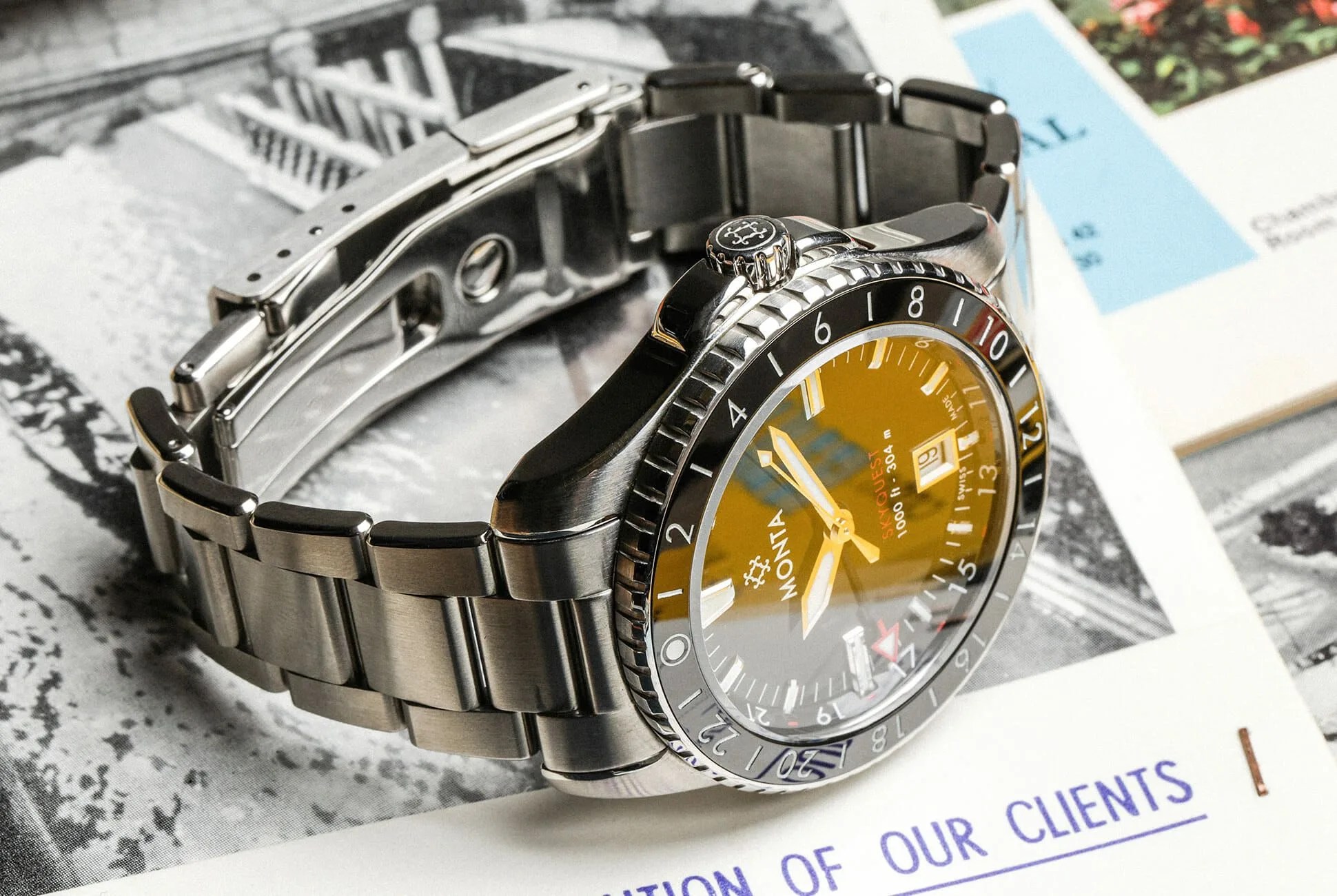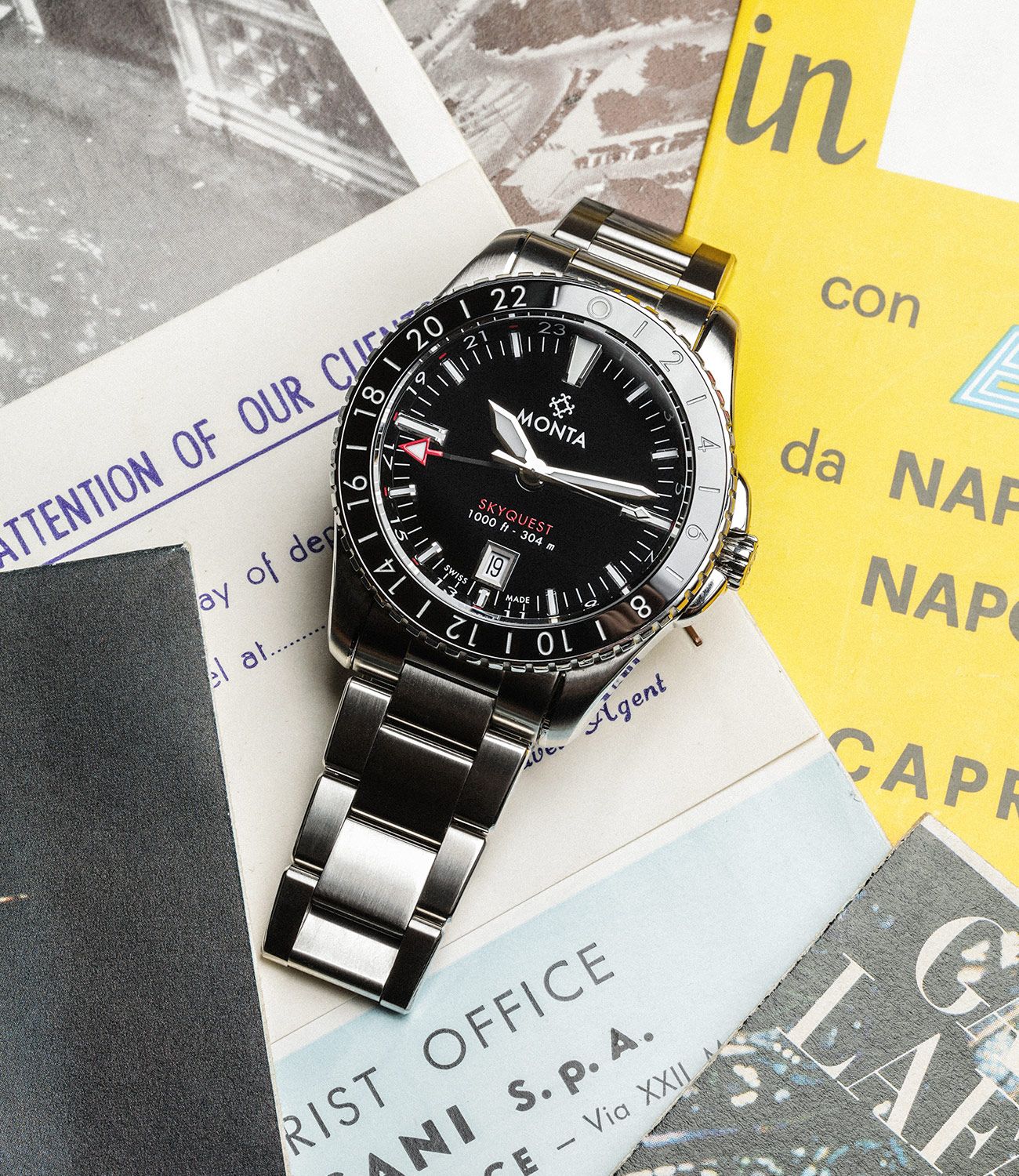4 photos
Ahh, the venerable GMT watch – that most useful of complications for travelers. Ever since Rolex released the now-classic GMT Master Ref. 6542 in 1954 for Pan Am pilots and crew, both watch enthusiasts and laymen have embraced the idea of being able to track a second time zone on one’s wrist. Most watch enthusiasts seem to agree that Rolex does this particular complication best, and anything without the Crown on the dial seems to be grouped into a vague “other” category. Thankfully, in the past few years, a new crop of GMT watches has come into existence that manages to combine dual or triple-time zone functionality with ruggedness and aesthetic appeal. Most recently, American microbrand Monta, based in St. Louis, MO, has developed the Skyquest, a new GMT watch that checks all these boxes and more.
The Good: “Tool” GMTs are a tough category in that you often have to drop several thousand dollars in order to acquire a good one. Monta, who re-jiggered the pricing on one of their original watch models in response to feedback from customers, has kept the price accessible with the Skyquest (at least with respect to value) – for $1730 on bracelet or $1575 on rubber ($1925 after the pre-order is over), you’re getting a pretty damn well-made watch. The Skyquest features the Selitta SW330 (essentially a Swiss-made copy of the ETA 2893-2) with independently-adjustable GMT hand and date at 6 o’clock, a bi-directional 24-hour ceramic or steel bezel, a screw-down crown and case back offering 304m of water resistance, a choice of steel Oyster-style bracelet or a vulcanized rubber strap in black or blue (plus a NATO strap with either option), two dial colors, and a 42-hour power reserve. You also get a parallel flat sapphire crystal with a unique seven-layer anti-reflective coating applied on the inside, giving the watch a very manageable case depth that easily sneaks under a cuff. This is a watch that, while taking the inevitable aesthetic cues from the classics, clearly features its own distinct design language and looks great to boot.
Who They’re For: When Rolex developed the original GMT Master for Pan Am flight crews in the 1950s, jet travel was new and still relatively expensive, and flying was a novelty reserved for the wealthy – indeed, the original GMT Master was a precision instrument designed with a specific professional in mind. Nowadays, of course, many more people travel quite frequently, and so the appeal of a GMT watch is wide-ranging, and anyone who is frequently crossing time zones or has family in another country will appreciate the ability to track a second (or third) time zone. The Skyquest appeals to this person, and has the added benefit of appealing to a particular subset of this person who can’t necessarily afford to drop $10k+ on a Rolex GMT Master, new or vintage. And because the Skyquest features dive-watch like water resistance and comes in multiple dial and bezel combinations, its appeal is even wider.
Watch Out For: Really my only gripe with this watch is that I struggled to fit the rubber strap onto the case, which likely has more to do with my own incompetence than with a design flaw from Monta. The rubber straps are extremely comfortable and well-made – they’re produced by Monta sister-brand Everest, which makes aftermarket straps specifically for the Rolex market. The ends of the included straps are curved to fit the Skyquest case, much like many of the Everest straps that are designed specifically with a Rolex Submariner case in mind. They curve upward toward the lug ends (difficult to describe – you really have to hold one in your hand), and for whatever reason, I found it extremely difficult to seat the spring-bars once I got one end in the lug hole. Other than this trouble with the rubber strap, I really do believe that any other gripes with this watch would probably have to be aesthetic ones, and these are largely subjective and depend on the individual wearer (I’m not crazy about the crown guards on this case, for example, but they’re certainly functional and someone else might love them). The only (perhaps) legitimate gripe I can see someone formulating concerning the watch would be that the Selitta SW330 features an individually-adjustable GMT hand, rather than an hour hand, but if you want this feature, you really have to shell out for a Rolex or similarly-priced offering.
Alternatives: As I mentioned earlier, there are finally some “affordable” mechanical tool-watch GMT options out there on the market, though many of them are priced above the Skyquest (the Lander from British micro-brand Farer is a noticeable exception at $1425, though I wouldn’t necessarily put it in the same bracket as the Skyquest in terms of robustness and inspiration; another option may be the Airman 42 GL0064, a watch with a similar feature set from Glycine’s famous Airman line that generally seems to retail for roughly $750, but I havne’t yet had my hands on any of Glycine’s new offerings – hopefully we’ll be able to get our hands on one of these for a review in the future). There’s the Oris Big Crown Pilot Pro for $1,595, but it doesn’t feature a rotating bezel, so tracking a third time zone is out. For $2630 you can grab yourself a Sinn 857 UTC VFR, which is a watch designed for use in extreme environments (though it features a 60-minute rather than a 24-hour bezel, so again, you can’t as easily track a third time zone, though you can dive with it). Of course, if you want to really go all out, you can spring for any one of numerous Roelx GMT Masters released over the years (good luck picking up the newest iteration, released in 2018, however).
